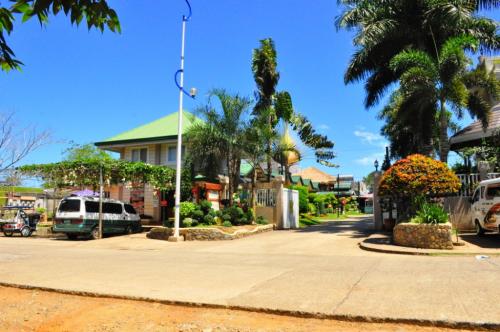
It is mere 24 km away from Tagbilaran City, the provincial capital of Bohol. According to the 2007 census, it has a population of 16,299 people.
Loboc is known for its floating restaurants along the scenic and winding Loboc River. Tourists also come to see the tarsier, a small nocturnal animal with large eyes. It is one of the world's smallest primates. Unfortunately, the tarsiers here are kept in an inadequate cage, and better be observed in the Tarsier Sanctuary in Corella.
Portions of the St. Peter Parish Church Complex (specifically parts of what is now the Convento or Priests' Residence) are thought to be the oldest standing ecclesiastical structures in Bohol Province. The Loboc Children's Choir has won numerous competitions both local and international, most notably festival competition in Barcelona, Spain entitled "Europe and its Songs", last September 17-21, 2003.
History
The early recorded history of Bohol point to the fact that the town of Loboc is the cradle of the Boholano soul. It was here during the first hundred years of the Spanish occupation of the Island that the distinct Boholano traits of deep religiosity, cohesiveness, dedication to traditional values and great love for music, was molded and given shape become what it is today.
Sadly, however, this fact is barely recognized.
Since pre-Hispanic times, Loboc has always been inland market village where produce from the sea were bartered for the agricultural goods of the upland regions. It is said to be the domain of Sigala, the other chief of Bohol, whose contemporary, Sikatuna, made the famous Blood Compact with Miguel Lopez de Legaspi in 1565.
In 1596, the Jesuit Fr. Juan de Torres came to Loboc from Baclayon to found the second oldest Christian settlement in the Island. After the traumatic Moro raid on Baclayon on October 26, 1600, the Jesuit Missionaries decided to move the center of their missionary activities to the inland village of Loboc. By 1602, Loboc became a Parish, making it the oldest in the Island. To the Jesuits, Loboc was the Residencia Boholana, where their local superior resided. It remained so until the middle of the 18th century when the exigencies of the times forced to them to move once more to Baclayon.
Around 1604, the Jesuits established a Seminario-Collegio or boarding school for native boys. This school laid the foundation of the musical culture of the town. At present, the name Loboc is synonymous with musical acumen, a fact recognized by all the people of Bohol.
The church of Loboc is one of the most beautiful in the entire province. Its history makes it the most interesting. The first stone church was built in 1602. It was destroyed by fire in 1638 and rebuilt beside the site of the older one. This is the Loboc Church presently standing, a fine example of the Jesuit colonial architecture of the 18th century.
Upon the expulsion of the Jesuits in 1768, the Augustinian Recollects took over and they proceeded to renovate the unfinished structure. They were responsible for the free-standing bell tower, the arcade facade, the mortuary chapel, the heavy stone buttresses and the unique three-storey convento built into the fabric of the Jesuit-built church of the 17th century.
Two saintly figures lived and were buried in Loboc church: Fr. Alonso Humanes, S.J. whose gravesite became the object of pilgrimages after his death in 1633, and the remarkable native boy, Miguel Ayatumo, a student of the Seminario Colegio, who died in the odor of sanctity at the tender age of sixteen in 1609. Contemporary Jesuit records speak glowingly of this Aloysius Gonzaga of Bohol.
Loboc Church contains a lot of interesting treasures. Among these are the decorative stone carvings and friezes on the exterior walls; a relief of St. Ignatius in polychrome stucco intriguingly hidden behind the main altar, seven ancient retablos from both the Jesuit and Recollect periods; ceiling murals done in the 1920’s by the Cebuano artists Rey Farncia and Canuto Avila, one depicting the miracle of Our Lady of Guadalupe, the town’s secondary patron, during the great flood of 1876; carved wooden cornices and decorative corbels shaped as gargoyles or mythical animals; and the unique three-story convent, perhaps the only one of its kind in the country.
Much of the early history of Bohol was made around the town and church of Loboc. It would not be an understatement to say that to know Loboc is to understand the entire drama of Bohol history. At present, Loboc church is deteriorating, ignored by tourists and visitors and continually threatened by the annual flood that has already robbed it of its ancient records and other priceless relics.
In 1942, entering by the Japanese troops occupied in Loboc, Bohol.
In 1945, entered from the liberation in Loboc, Bohol by the Philippine Commonwealth troops together with the Boholano guerrillas against the Japanese forces at the end in World War 2.
Loboc is truly Bohol’s forgotten and neglected soul.
Barangays
Loboc is politically subdivided into 28 barangays.
* Agape
* Alegria
* Bagumbayan
* Bahian
* Bonbon Lower
* Bonbon Upper
* Buenavista
* Bugho
* Cabadiangan
* Calunasan Norte
* Calunasan Sur
* Camayaan
* Cambance
* Candabong
* Candasag
* Canlasid
* Gon-ob
* Gotozon
* Jimilian
* Oy
* Poblacion Sawang
* Poblacion Ondol
* Quinoguitan
* Taytay
* Tigbao
* Ugpong
* Valladolid
* Villaflor
Source: